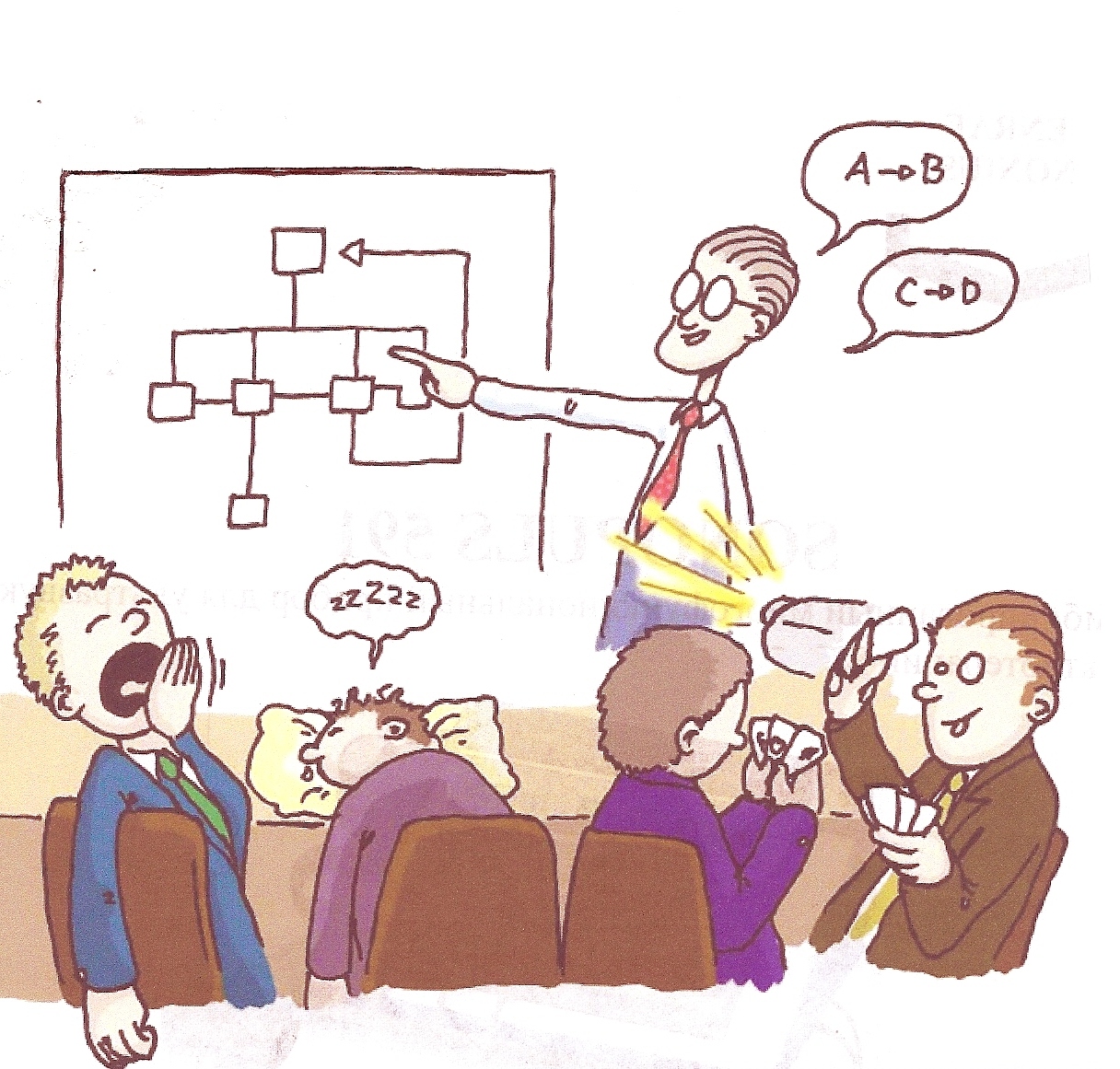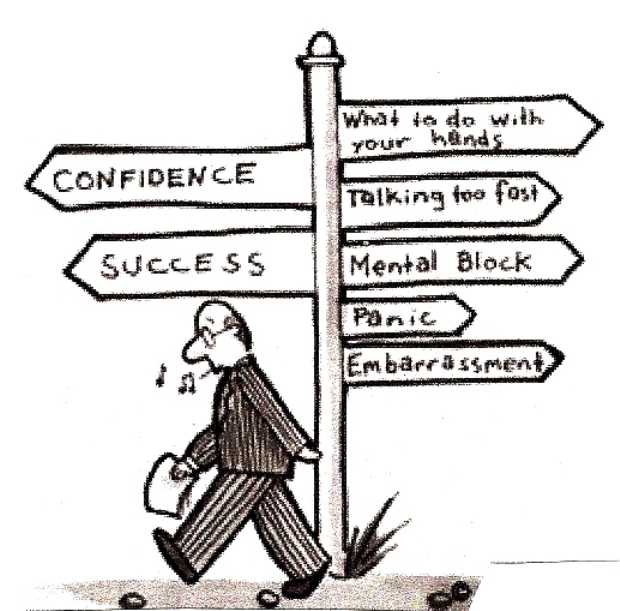
- •Improving Communications
- •Oral communications
- •Written communications
- •7 Tips to become a Good Conversationalist
- •Six Common Mistakes That Spoil Conversations
- •1. Blabbermouthing
- •2. The "take-away" and "me-too" syndrome
- •3. Unsolicited advice
- •4. Interrupting
- •5. Contradicting
- •6. Stingy contributors
- •8 Правил знайомства з діловими партнерами
- •18 Ways to improve your body language
- •6 Чарівних букв
- •Voice and Language
- •Visual aids
- •Fail to prepare
- •No weak opening
- •When I know I have to make a presentation, even a small one before a very limited number of people, I start feeling nervous…
- •When a big meeting is coming up, one that will involve a number of presentations from a range of people…
- •I would say my ability as a presenter is…
- •While I am up on stage, I…
- •Comments about my presentations are generally…
- •If I have to go “off the cuff”…
- •If I could describe public speaking as a food, it would be…
- •Visual aids versus handouts
- •Я к вдало провести ділову зустріч.
- •Introducing the Agenda
- •Introducing the First Item on the Agenda
- •1. What is the desired outcome of the meeting? (How will you know the meeting was successful?)
- •2. Who needs to be there? (And who doesn’t?)
- •3. Is the agenda prepared? (If not now, when?)
- •4. What can I do to prepare? (How can I help others prepare?)
- •5. What can I do to make this meeting succeed? (What is my responsibility?)
- •Discuss the following questions:
- •Exercise 6
- •Negotiating
- •Well, we could make it 7,5 % .
- •The trouble is, the general manager isn't very interested in marketing. He's only concerned about …..5…... If you make it 10%, I might be able to persuade him.
- •But you said…
- •6 Найпоширеніших помилок при проведенні переговорів
- •Communicating with someone in writing
- •The salutation
- •The subject title
- •The body of the letter
- •The parting
- •The signature
- •Inquiries (Enquiries)
- •Поради при написанні ділових листів
- •……………: Always proofread and edit your letters.
- •Avoid the use of …..1….. Words
- •Informal Style Formal Style
- •Identify yourself, if necessary
- •Include necessary information
- •Ten keys to writing an essay
- •Budget your time carefully
- •Read the topic carefully
- •Plan your essay before you write
- •Be sure your handwriting is as clear and legible as possible
- •Follow a clear, logical organization
- •Topic Type a: Contrast/Opinion
- •Use concrete examples and specific reasons
- •Use signal words to indicate transitions
- •Use a variety of sentence types.
- •Check your essay for errors.
- •Електронна пошта
- •Chief, Guy, Sport
- •My Buddy
- •Assumption Junction
- •Peak-a-Boo
- •2 (Suggested answer)
- •Listening 4
- •Contents
- •References
Voice and Language
Remember, all your audience wants from you is to walk away with one or two key points that will make a difference to them. If you structure your talks to deliver this result, you can avoid lots of complexity that isn't really needed. This coupled with appropriate humour, can go a long way to making your presentations easier, enjoyable, illuminating and entertaining for your audience.
Speak with passion, slightly slower and louder than usual.
Avoid a dull monotone. Vary pitch and tone.
Avoid idioms or complicated expressions if not all participants speak your language fluently.
Repeat key concepts slowly.
Vary the speed – faster to excite, slower to emphasize.
Catch attention with a silence – don’t be afraid about pauses.
Enunciate and modulate!
Watch out for nervous “tics”: “Uh”, “OK”, “right”, “er”, “you know”, “I mean”.
Use active voice, short sentences, short words.
Avoid generalizations, clichés, redundancies and jargon.
Be clear, concise but complete.
Body language
An American University (UCLA) research into communications showed that a speaker influences an audience in the following way:
Spoken Words 7 %
Voice 38 %
Body Language 55 %
Be natural. The body language should always match the words at the appropriate moment. Keeping your hands by your side or resting them on the lectern will have them ready for action. This is better than having them in your pockets or clenched behind your back where they aren’t in a position to be ready to start working. Avoid pacing, rocking, swaying, or leaning / slouching on the lectern as this will be distracting to the audience, a sign of nerves and will prevent the upper body from using body language.
Maintain sincere eye contact with your audience to make everyone feel involved, but NEVER stare at one person. Sweep the audience with your eyes, 2 – 3 seconds per person. You can also divide large audiences into halves, quarters, and spend 3 seconds on each section.
NEVER:
look at your slides
turn your back on the audience
look elsewhere than the audience
Dress to feel comfortable and confident. Find out as much about your speaking event as you can, look through all of the appropriate outfits in your closet, and choose the one in which you feel most comfortable. When you feel comfortable, your confidence increases, and therefore so does the quality of your presentation.
Visual aids
Use audio-visual aids or props for enhancement if appropriate and necessary. Master the use of presentation software such as PowerPoint well before your presentation. Do not over-dazzle your audience with excessive use of animation or sound clips that are inappropriate for your topic and avoid torturing them by putting a lengthy document in tiny print on an overhead and reading it out to them.
Be sure all necessary equipment is set up and in good working order prior to the presentation. If possible, have an emergency backup system readily available. Check out the location ahead of time to ensure seating arrangements for audience, whiteboard, lighting, and location of projection screen, sound system, etc. are suitable for your presentation.
Have handouts ready and give them out at the appropriate time. Tell audience ahead of time that you will be giving out an outline of your presentation so that they will not waste time taking unnecessary notes during your presentation.
DEALING WITH QUESTIONS
“I can evade questions without help; what I need is answers.”
John F. Kennedy
Answer questions if appropriate and time permits. If a question takes you too far off topic, offer to answer it after the talk is over. If you disagree with a questioner’s point, validate their perspective first before offering an alternative. Repeat the question and clarify it if you need to. This helps others hear what was said and ensures that you are answering the question that was asked.
Even oddball questions can be opportunities to go deeper into the topic. A master takes what appears to be a stupid question and answers it so eloquently that in retrospect the question seems brilliant.
CONCLUSION
“Be sincere, be brief, be seated.”
Franklin D. Roosevelt
In conclusion, (let it not be the phrase that wakes up the audience), for effective and memorable presentations, one should:
Know the audience and realize that the audience wants you to succeed.
Know your material.
Relax.
Visualize yourself making the speech-visualize success and you will be successful!
Don’t apologize- for any problems you think you have with your speech, you may be calling the audience's attention to something they hadn't noticed.
Concentrate on the message - not the medium-focusing attention away from your own anxieties, and outwardly toward your message and your audience.
Turn nervousness into positive energy-harness nervousness and turn it into enthusiasm and vitality.
… And finally “just do it!”
Reading comprehension
Exercise 1
Interpret the quotations from the text.
“Never overestimate an audience’s knowledge, never underestimate their intelligence.”
“In all things success depends in previous preparation, and without such preparation there is sure to be failure.”
“The human brain starts working the moment you are born and never stops until you stand up to speak in public.”
“I can evade questions without help; what I need is answers.”
“Be sincere, be brief, be seated.”
Exercise 2
Define the sentences as True or False.
Stage fright, speech anxiety or talking terror is common for inexperienced speakers.
Fear of public speaking is one of the greatest fears people have.
People assemble for the speech because they expect to hear or learn something new.
Successful speaking is determined by how well you have prepared your notes.
If you run out of time, go on speaking; the audience will appreciate your efforts.
People tend to learn better the last things they hear/see.
Grab their attention with a provocative statement, a question or a humorous anecdote.
Speak with passion, slightly slower and louder than usual.
Don’t vary the speed.
Sweep the audience with your eyes, 2-3 seconds per person.
Exercise 3
Match the halves to make the phrasal verbs used in the text and use them in your own sentences.
|
|
Exercise 4
Complete the sentences.
If you correctly understand the hidden causes of ...
Speeches serve a variety of purposes, but ...
Before you begin to prepare material, you need ...
It is important to speak at ...
Audiences will appreciate your respect of ...
Keeping your hands by your sides or resting them on the lectern is better...
When you feel comfortable, your confidence ...
Be sure all necessary equipment is ...
If a question takes you too far ...
Look through the text once again and get ready to speak about the main points of public speaking:
|
|
Translate into English
Публічним виступом може бути, як виступ на конференції, лекція, так і тренінгові заняття.
Дослідження по темі страху показали, що найбільше людина боїться виступу перед аудиторією, на другій позиції виявився страх смерті.
Cтрах публічного виступу великою мірою впливає на результативність, ефективність та зацікавленість виступом.
Страх – це комплекс біохімічних реакцій, які характеризуються наявністю адреналіну в крові.
Якщо ціль добре сформульована, то стає зрозумілим, що і яким чином ми будемо говорити.
Крім того, що виступ перед публікою повинен бути структурованим, містити елементи жартів та мати чітко сформульовані цілі, він має приносити нам задоволення.
Bикористання у виступі жартів, компліментів дає можливість привернути увагу аудиторії та сформувати позитивне ставлення.
Exercise 1
Tips on public speaking
When you stand up to speak in public, what keeps an audience interested in what you are saying? Expertise or enthusiasm? PowerPoint or natural presence?
|
|
Here is a quick list of the 15 tips on public speaking which every effective public speaker should know. Match the tips (1-15) with the sentences explaining them.
Research the topic well.
Convey the message clearly.
Organize ideas coherently.
Support it with relevant stuff.
Employ metaphors or analogies.
Be a good storyteller.
Open and close with a bang.
Enliven it with humour.
Modulate your voice.
Dramatize with gestures and facial expressions.
Take advantage of visual aids.
Connect with your audience.
Go for active precise verbs.
Know your time limit.
Be prepared for unforeseen situations.
Make sure your ideas flow seamlessly and accordingly; so your audience can follow you.
Everyone loves a good story. Stories are powerful. Exploit them to deliver your message and capture your audience attention.
Make eye contact to show that you are sharing the speech with them. It also reflects that you are confident and friendly.
Use quirky quotations, fascinating facts, and startling statistics to complement your material.
Do not drone. Play with your voice: its tonality, volume, pacing and pauses too.
The content of your speech should be thoroughly researched.
Make use of metaphors or analogies to enhance your talk. They are great ‘visual aids’ to your oral speech, so to speak.
Always arm yourself with some humorous lines, extra visual aids, spare slide projectors, etc. Have an alternative option to handle every situation.
The key message of your speech should be laser-focused and easily understood.
The opening and conclusion of your speech should be powerful and memorable.
Stress your main points with exaggerated hand gestures or facial expressions for effect.
They are clearer and direct. Drive home your message with strong active verbs.
Make use of public speaking jokes sparingly and appropriately throughout your speech.
Make sure you end your speech on time. No more, no less.
Your visual aids are there to support you. Make sure they do their job well.
Exercise 2
There is no doubt that Barack Obama has strong communication skills.
|
|
Here are 10 traits that make Barack Obama a fine public speaker:
Tempo. Have you ever noticed that Barack, even when flustered, seems to keep an upbeat and fluid tempo? Voters respond to his ability to “keep the conversation” moving.
Eye contact. When Mr. Obama speaks, he looks at the whole audience. His eyes are constantly scanning and he wants everyone in the audience to know that he is speaking personally, to them.
Voice inflection. Barack Obama alters his pitch in his voice – up and down – depending on the sincerity of the problem or jovial account of the joke.
Demeanor. There is a “swagger” or a confidence that exudes from his veins. Not everyone has to agree with what he says, but they do have to respect it. His demeanor plays a major role in that understanding.
Body language. When that finger gets pointing, the audience understands the importance of that particular issue.
Pauses. Barack lets what was just stated “sink in” to the audience. He pauses when necessary to give the focal statement extra power.
Visual imagery. Mr. Obama paints a picture for the crowd. He tells stories. He allows the listener to get involved.
Preparation. Okay, okay – your speeches would probably be much different if you had a teleprompter in front of you as well. However, Barak seems to have done his homework before he hits his target audience.
Know your audience. If you’ve followed Barack Obama’s campaign, you know that he distinguishes greatly his speaking style depending upon whom he’s talking to. He’ll change his tempo and style if he’s speaking with a crowd in Iowa as compared to one in Miami.
Confidence. You can’t coach confidence. Barack has it. Whether that confidence rubs the wrong way to some, is yet to be determined.
Exercise 3
1. Unfortunately not all presentations are successful. Look at the picture and write down 10 possible mistakes made by the speaker.

Compare your answers with your partner’s.
2. Read the article about public speaking mistakes. Have you found any on your list?
Public speaking mistakes
There are six public speaking mistakes you should avoid if you want to deliver powerful speeches or an impressive presentation. Check them out below:
|
|



